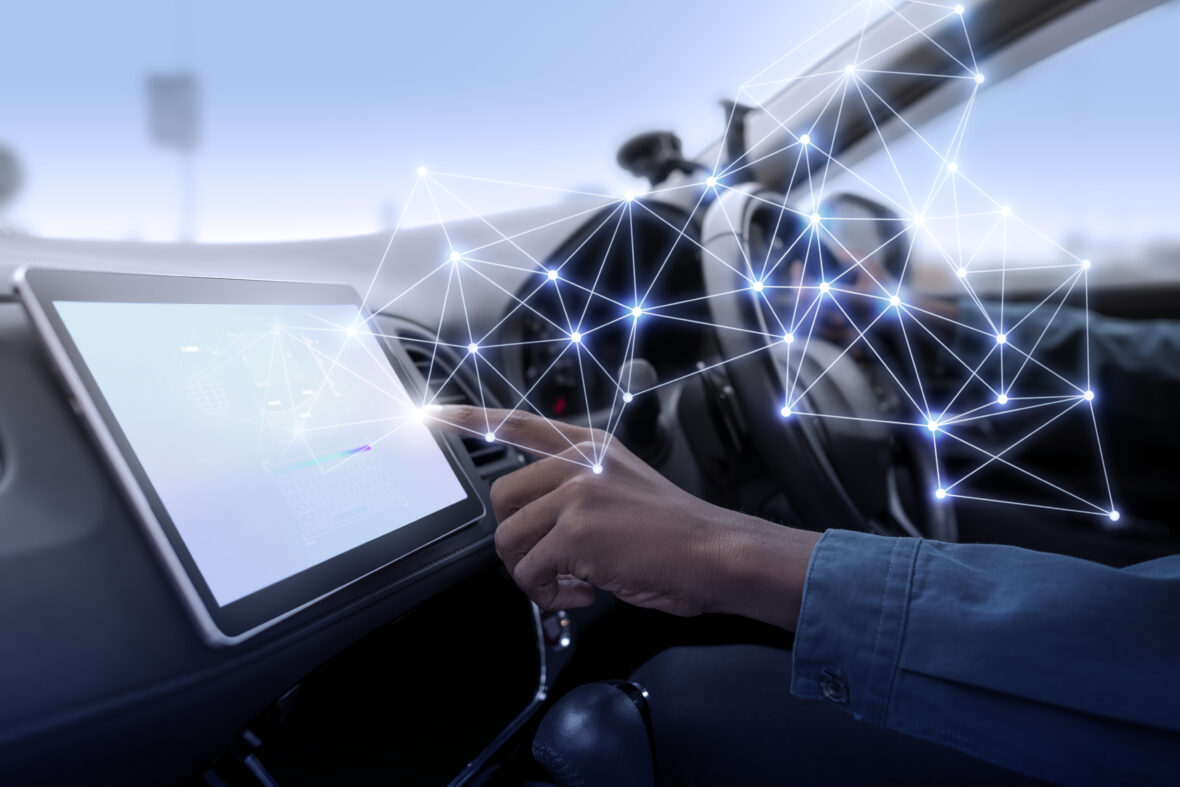Artificial intelligence is becoming what electricity was for our ancestors: a revolution. Indeed, AI is invading our daily uses and disrupting every industry, from health and communication to transportation. The car is no longer a means of transport but a real data center on wheels. Mobility has been entirely redesigned thanks to data and any field will be affected by this revolution, from the assembly of the car to the content available on board.
This artificial intelligence will radically transform the car of the future by adding autonomy that will reduce accidents, help us park, and even drive for us. Thus, the software, i.e. all the programs of a computer system is also being rethought.
Artificial intelligence in autonomous cars
The notion of an autonomous or automated car refers to a vehicle capable of driving without a driver on an open road. The first prototype of an autonomous car is not so recent: in 1977, Japanese researchers developed a technology capable of following the trajectory of a car using cameras and markers on the ground. 10 years later, the European Commission financed the Prometheus project, worth 800 million euros. This investment enabled the development of autonomous driving technology tools in the major achievements of the 2000s, marking a turning point in the mobility industry. In 2014, after conquering the electric market, Tesla tackled the autonomous car market. The introduction of Autopilot is the first reference in terms of driving aids, considered semi-autonomous but already extraordinarily effective. Elon Musk, creator of Tesla, is the true pioneer of this new automotive era.
It is a field in constant progression with 5 existing levels of autonomy. Today, professionals in the field agree that the car is between the second and third level of possible autonomy. Vincent Abadie, Vice President & Senior Expert ADAS Stellantis, explained at the 2022 Paris Motor Show that a sufficient level of autonomy has already been reached in France: “Our approach is to help the driver free up time and get rid of the driving action. We are currently at 50% autonomy, we are approaching level 3, where in certain circumstances, the driver will be able to let go of the steering wheel without using the pedals”.
The first level of autonomy, which has now been more than achieved, was to provide safety on board the vehicle. And this safety, to be optimal, had to call upon important assistance like the installation of the cruise control or the ABS (system of antiblocking of the wheels of a car, allowing optimal braking). The second level is the implementation of automatic driving with tasks that do not require the intervention of the driver. This is the real beginning of the autonomous era. Although drivers are still very vigilant, many possibilities are available thanks to autonomy. This level makes it possible, for example, to assist drivers when parking or to them not to cross the white line on the highway. The next logical step is the implementation of full autonomy on overtaking and driving skills, which is already present in Teslas with the autopilot. So the third stage offers a car that is sufficiently equipped to take into account the outside environment.
Today we are at the dawn of a new page in the history of the automobile, this fourth level will totally redefine the codes of driving. The latter will not even need human help anymore. Even if the car faces danger, the high level of automation will be able to make the right decisions by managing the problem on its own. Many level-four autonomous car prototypes show an absence of pedals and steering wheels on the driver’s side, such as the Aicon model from the German brand Audi. Some Americans have already had the chance to test fully autonomous cabs. Indeed, Cruise, the division of General Motors in charge of developing autonomous vehicles, has set up driverless cab robots capable of making trips and taking customers in some areas of California. Pierre Maillot, Vice President of Business at Heex Technologies said that this AI had to be adapted and re-educated according to the country and region: “The data that AI uses makes autonomy contextualized. In San Francisco, robot cabs are already making autonomous runs. The same robots in Paris would need to be contextualized to drive properly. So data is key.” This is a very important first step for a burgeoning industry, showing that with the help of data, AI is making autonomy real.
“Autonomous cars are the replacement of the driver, and we are working to recreate driving intelligence. In autonomy we will gradually replace the driver” said Vincent Abadie – Vice President, Senior Expert ADAS Stellantis. Autonomy within vehicles allows us to rethink our experience within the vehicle. Indeed, thanks to the AI present in the autonomous car, vigilance will be less necessary than before. Thus, the driving experience will be completely new. The balance between hardware and software is being re-imagined; the driver has a lot of free time and as a result, content within vehicles is becoming more and more important.
In-vehicle software and content redefining the travel experience
Software is the name given to what encompasses both operating systems and applications. With the explosion of artificial intelligence, the design of the car is totally revised. Car manufacturers are starting to shift from hardware to software because the future of the car is now in this part of the car. Tesla has played a huge role in this transfer between hardware and software. At the Paris Motor Show, Guillaume Rio, head of technological trends at BNP Paribas, explained how Tesla’s employees are divided between the software and hardware divisions: “At Tesla, 70% of employees work on software”.

We are currently experiencing a real transition in the use of vehicles, moving from a quick way to get between two places to a real experience enriched with services. Thus, innovative startups are shaking up the automotive world by giving a fresh look to this aging field. Until recently, the center of gravity of the car was the performance of the engine with the other components of the car, today, manufacturers must focus on the services inside the vehicle. We often talk about “smart cars”, intelligent cars capable of driving themselves but also of creating a real experience on board. The idea is above all to use the time of the journey usefully, even more so with the ever-increasing automation of vehicles. The combination of content strategy and audio technology could answer this question of useful travel time. This was explained by etx majelan, present at the 2022 Paris Motor Show to announce its strategic partnership with Continental, consisting of providing via the e-Travel companion application content in synthesized voice and a selection of podcasts from Majelan’s catalog. Jérôme Doncieux, CEO of etx majelan, insisted on the importance of audio in mobility: “Audio mobility means accompanying the driver throughout the day. In a context of digital fatigue, audio appears to be the solution to free the senses and the user’s time.

“This new era marked by mobility and artificial intelligence appeals to many people and many market players want to jump on the bandwagon. Indeed, many start-ups are trying to play a role in this automotive revolution, but also large groups like Sony who wants to become a key player in the automotive industry. The Japanese conglomerate is setting up a division dedicated to electric cars and a partnership with Honda. This decision is unexpected but not surprising either, as the automotive sector is taking a turn essentially towards technological and technical services. At the Paris Motor Show, Xavier HORENT, Managing Director of MOBILIANS, said that “the latest cars are made up of 100 million lines of code, whereas in 2030, they will be around 1 billion lines of code.”

At ETX Studio, we have been working for several years on the added value of audio within the vehicle. From the first AEX project imagined with Renault in 2018 to the realization of our strategic agreement with Continental, we have always believed in the power of audio as a medium of information, emotions and entertainment. With our combined expertise in synthetic voice technology and Majelan’s expertise in podcasts, we aspire to become the leader in audio mobility.






